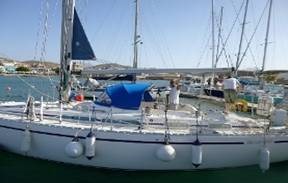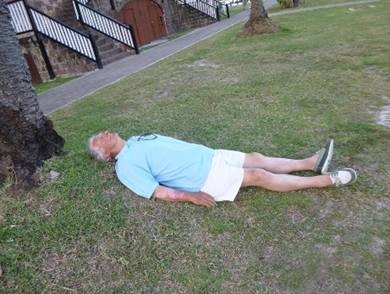The Trip Across

SummaryThis is a brief description of our experiences during the crossing from Las Palmas to Antigua via Mindelo in the Cape Verde Islands. It is intended to illustrate the main highlights of the voyage to friends and family, rather than give a detailed description to a wide audience. The first page is mainly background information to “set-the-scene” and can be missed if you are already aware of these items. People InvolvedWe had decided during the planning stage of the voyage that the ideal number for this type of trip is 4 people. This allows for longer periods Off-Watch and so reduces fatigue if the weather is rough. The down side is that this also means that food and water is consumed at a faster rate. We did the calculations though and thought it a good trade off.
We had also decided to make the voyage in company with another yacht called “Bluejacket” Sailing in company provides a means where there is help available in an emergency, though it does mean that one boat will need to slow down for the other, depending who is fastest. “Bluejacket is owned by Mike and Gill who we had met and became good friends with while we were in Marmaris, Turkey. They were making the crossing at the same time and had arranged for 2 guys (Dave and Nick) from the British Airways sailing club to accompany them as crew.
On “Shamal” there was Georgina and our son-in-law Olly as crew, with myself as “Skipper”. We also had Don Craig on board as an additional crew member. Don was recommended to us by Mike.
So, the people involved were; Gill, Mike, Nick and Dave on “Bluejacket” and Georgina, Olly, Don and myself on “Shamal”. Route:Although the trip actually started in Cyprus where we had kept the boat the previous winter, the Atlantic crossing part started in Las Palmas in the Canary Isles. This is where we did the final prep on the boat and where Don joined the crew. Southern TradesThe key to the route is the Southern Trade Winds. These are winds that start to blow from about November to June and are generally from the north/east at between 15 to 20 knots. The area where they exist is in a band that stretches across the Atlantic, starting at about 500 miles south of the Canaries and extending a further 500 miles taking in the Cape Verde Islands, down to the Doldrums. (Where winds are generally absent). I say “generally” because the Trade Winds do vary in intensity and direction, but they are seen as the best means for a sailboat to cross the Atlantic to the Caribbean. There is also a west flowing current of about 1 knot in that area, which will also help with the passage. So most sailboat crossings involve heading south from the Canaries until you pick up the trade winds and then turn west. We decided to break the voyage by stopping in the Cape Verde Islands and then depart from there.
It is said that if you kick a football into the sea off the Cape Verde islands, it will arrive in the Caribbean in about 3 months. We hoped that we could improve on that time! The CrossingDeparting Las PalmasDon arrived on the 3rd December 2012 and after a day of briefing him on various drills and how the boat worked, we departed Las Palmas marina on the 4th December. The sail down to the Cape Verde Islands took 6 days to cover 800 miles and was completed in good weather and fairly fast sailing.
Georgina and Don as we leave Las Palmas Good Sailing to the Cape Verde’s Mindelo
Mindelo Harbour The Cape Verde Islands are mountainous and very arid. They were once the centre of the slave trade and have a very “African” feel to them. We found the people we met very friendly. There is however only 1 marina capable of taking sailboats in the Cape Verde’s at Mindelo on S. Vicente, so that is the only bit we saw. We spoke to people who visited other parts. They say that they found it interesting but very “basic”.
We met up with “Bluejacket” shortly after we arrived in Mindelo and went into the marina to get some last minute jobs done before we departed for the “serious bit”. Setting OffNick flew in on the 14th December to make up “Bluejacket” crew and Olly arrived on the 15th to complete the crew list for “Shamal”.
We had a final lunch on shore and to psych ourselves up for actually starting the voyage. It was a rather tense time as after all those months of planning, “The Day” had finally arrived.

Two Crews – From Front/Left clockwise round the table – Dave, Georgina, Olly, Gill, Mike, me and Nick. (Don taking the photo)
Then we were off….
“Shamal” departing from Mindelo at the start of The Crossing
The CrossingThe Crossing itself was a mix of everything: It started with strong winds and lumpy seas with cold nights. But the temperatures gradually increased as we headed west and the seas became a bit flatter.
We split the day into 4 hr watches during the day with 2 hour watches at night. Once the sails are set, there isn’t actually much to do unless the wind changes and the sails need adjusting or something goes wrong. So the voyage can be described as a procession of watches, interspaced with meals, the odd navigation check, sail change and then sleep. Every so often however, something of note did occur……
ProblemsThe only real problem we had to deal with was when our alternator stopped working. This is the main source of power on the boat to keep the batteries topped up. Without battery power we would have no fridge, lights or navigation instruments. I guess that we could have managed without these (Christopher Columbus did!!) But fortunately I had a spare and we didn’t need to try. Changing it while the boat rolls about was tricky though. Olly was very handy with these types of things. Weather
“Bluejacket” Riding the Waves
Because the wind is generally behind us as we head west, it doesn’t push the sail from the side. This means that the boat tends to be a bit “rolly”. We also had quite high waves coming from the north as the result of storms in the north Atlantic. These were over 4m high but very long from crest to crest. So the boat just slowly rode up one side of the wave and down the other and we didn’t feel any real discomfort. Sleeping is an art as you need to wedge yourself into a corner or hold yourself into the bunk with a lee-cloth. Don didn’t put his lee-cloth on one night and fell out with a clatter that woke the boat up. He didn’t forget after that! By the time we were half way across the weather was generally tropical and we stayed in shorts and tee-shirts the whole time.
Even when the sea was a bit rough, no-one was seasick but cooking becomes a problem as nothing stays still. We also had to keep a watch out for squalls. These are lines of VERY heavy rain with associated strong wind. Although we saw many in the distance and we experienced heavy rain as the edge of one went by, we were never actually hit by one straight-on.
Line Squall in the distance
We were also affected by very low winds on 2 occasions and needed to motor through them. The compensation for the calms was spectacular sunsets and the very clear star fields that you get at night.
Sunsets in Mid Atlantic Cooking/ProvisioningThere are big markets and supermarkets in Las Palmas, so that is where we stocked up on provisions. Georgina bought some vac-packed steak, chicken and lamb in the El Corte Ingles food hall. The steak and chicken were great, but the lamb went bad and had to be thrown over the side. Other food stuffs were mainly tinned or packet items.
Because of the monotony of keeping watches, food is quite important. It is however very frustrating trying to do anything in the rolly conditions that prevail. Anything not attached to the boat rolls or slides around the surface, where you thought that you had left it. Preparing and serving food particularly becomes a real challenge, so we tended to cook 1-pot meals if possible. There were 2 exceptions to this. One was on Christmas and the other was Olly’s Birthday when Olly caught some fish. Olly’s Fish
Fishing Machine
Fishing is also something to be done to supplement “ships supplies”, but also something to the relieve boredom. It’s not exactly strenuous though as all you do is set out a lure and see what bites. Olly however became the main fish-catcher and managed to come up with 2 good sized Dorado and a small tuna. Dorado particularly is delicious if cooked lightly and we served these with potatoes, veg and a parsley sauce. Tricky to do but worth it.
We would also hear the odd flutter and thump in the night. It took us a while to work out what this was, but then we would discover a couple of wayward flying fish lying on the deck next morning.
Olly tried to claim these as “catches” but I thought that a little cheeky. ChristmasThis was celebrated as best we could. Olly supplied the Christmas Pudding, which he brought out from England…. and the silly hat!! We had good weather that day and fairly flat seas so cooking wasn’t too difficult, We had the full works….roast potatoes, stuffing, cabbage, peas, carrots and gravy with the vac packed whole chicken.
Christmas Day 2012 at sea
Whales and Dolphins |






















